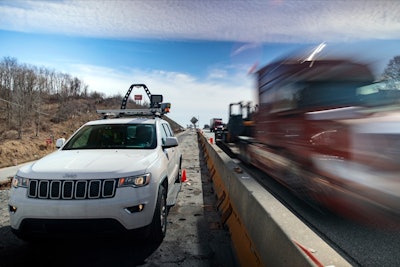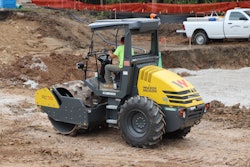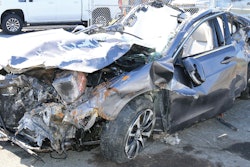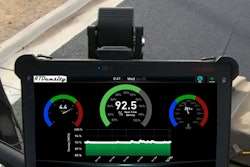
Three more states will place automated speed cameras in construction zones, joining a small group of states using the devices to increase safety for road workers and the driving public.
This month, Washington Gov. Jay Inslee signed a law that would allow automated cameras in road work zones starting in July 2024.
The law expands the state’s current use of automated enforcement but also comes with some limits. Drivers must be given warning signs ahead of the enforcement area. The cameras can only be used in active work zones on state roads for catching speeding drivers. Those caught speeding on camera will get a ticket in the mail.
Connecticut and New York have recently adopted pilot programs for work zone cameras.
New York began rolling out its pilot program April 17, which coincided with the annual National Work Zone Safety Awareness Week, which ends April 21. Thirty speed monitoring vehicles have been dispatched throughout the state to highway work zones. Drivers will get warnings during the first 30 days of the program. After that, tickets with fines will be issued.
A first violation results in a $50 fine; second offense, $75; and third and above violations result in $100 fines.
In Connecticut, under its new pilot program, three SUVs will be equipped with radar and cameras for catching speeders going 15 mph or more over the speed limit. The SUVs can only be stationed at designated work zones, and their locations are publicized in advance on the Connecticut Department of Transportation’s website.
The first violation comes with a warning; second offense is a $75 fine. Subsequent violations carry a $150 fine.
Do they work?
Pennsylvania adopted a pilot camera program in 2020, which has netted more than 1 million notices of violations for work-zone speeders, according to the Pennsylvania Department of Transportation. The program ends this year, but PennDOT has asked the legislature to extend the program or make it permanent.
In its 2023 annual report for Automated Work Zone Speed Enforcement, the agency says the program has reduced speeding to 17% of all traffic in work zones where it has been deployed. Excessive speeding, defined as 11-plus mph over the speed limit, has been reduced to 2.6%. Crashes have dropped by about 100 compared to pre-pandemic levels.
“The maturation of the AWZSE pilot program has provided benefits to the crews in work zones around the Commonwealth, as well as for those traveling through these work zones,” the report says. “The data has shown that AWZSE is an effective tool in improving work zone safety across the Commonwealth, counter to national trends of increasing work zone crashes.”
The report says the AWZSE team has discussed the program with 25 other states.
The cameras can only be used when road workers are present in work zones on limited-access highways. Drivers going 11 mph or more over the speed limit receive a warning on a first offense, a $75 fine for a second offense, and a $150 fine for subsequent offenses. Camera operations are conducted by a private company, and tickets are issued by state police by mail.
PennDOT says the program is not designed to generate revenue. Instead, the goal is “to reduce work zone speeds, change driver behavior and improve work zone safety for workers and motorists,” according to the AWZSE website. The locations for the cameras are posted on the site to give the public advanced warning. Signs are also posted ahead of the work zones to warn drivers of the camera enforcement.
Six highway workers killed in crash
The use of the automated speed cameras in U.S. work zones has been the result of deadly crashes, which have risen 46% between 2010 and 2020, according to the National Work Zone Safety website.
There were 774 fatal work zone crashes in 2020, killing 857 people. Of those, 117 were workers.
Those statistic are among the numbers the construction industry has been highlighting during the National Work Zone Safety Awareness Week. The week’s events come a month after six highway workers were killed on I-696 near Baltimore. A preliminary crash report from the National Transportation Safety Board notes that the driver who crashed into that work zone March 22 had been speeding.
The driver had changed lanes and struck another car and then spun out of control. The car entered an opening in the concrete barriers and went crashing through the zone, striking and killing the workers. The driver of the other car was also speeding through the 55 mph zone, NTSB said. NTSB is still investigating to determine probable cause of the incident.
Maryland was one of the early adopters of automated speed enforcement cameras. Its statistics are often cited in the ongoing debate about automated enforcement as evidence the cameras work by reducing traffic speeds in work zones. Violators are fined $40.
Which states have work zone cameras?
Opponents argue that automated speed cameras represent government intrusion into private citizens’ lives and that other methods are more effective. Mindful of those concerns, states adopting work zone cameras have placed tight restrictions on how and when they are used.
At this point, though, most states do not use automated work-zone speed enforcement. According to the Insurance Institute for Highway Safety, these states, other than the ones mentioned above, use automated speed cameras specifically for work zones:
- Colorado – $40 maximum penalty.
- Delaware – pilot program, only for I-95 construction project in Wilmington and ends when that project ends. A bill has been introduced in the state legislature for speed cameras in work zones statewide.
- Illinois – citations can only be issued in work zones where workers are present.
- Iowa – not state law, only allowed under city ordinances.
- Louisiana – only in work zones operated by the state when workers are present.
- Oregon – tickets can only be issued by a uniformed officer in a marked squad car in work zones when workers are present.
- Virginia – allowed in highway work zones, with fines not to exceed $100.
Contractors report rising work-zone crashes
The Associated General Contractors released a survey in 2022 that showed 64% of responding contractors reported that drivers had crashed into their work zones in the previous year – a 4 percentage point increase from the 2021 survey.
They cited distracted driving due to phone use as the No. 1 cause of work zones being more dangerous, at 81%. Speeding came in second at 71%.
Contractors surveyed listed methods they thought would combat the problem, with automated speed cameras and ticketing coming in fourth place, at 55%.
Other safety methods they recommended:
- Stricter enforcement of existing traffic laws – 67%
- Stricter laws against cellphone usage while driving – 61%
- Closing roads and detouring traffic – 61%
- Tougher laws and fines for traffic violations in work zones – 47%
- Better, more frequent training for workers – 23%











